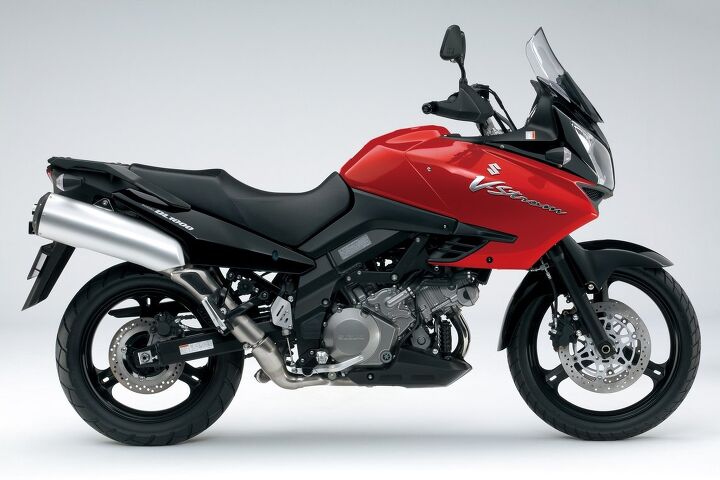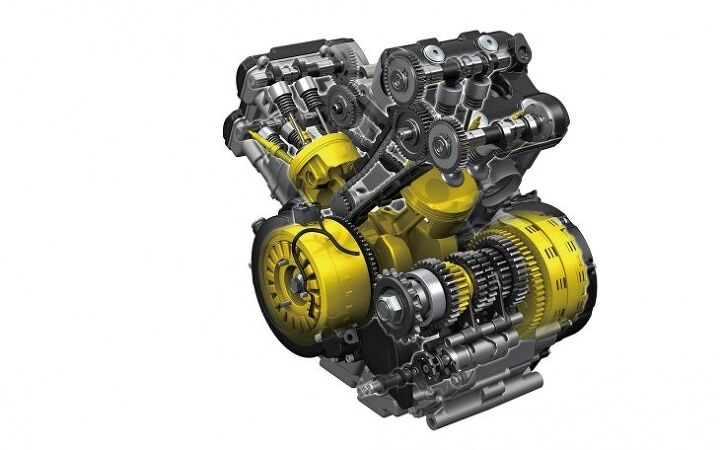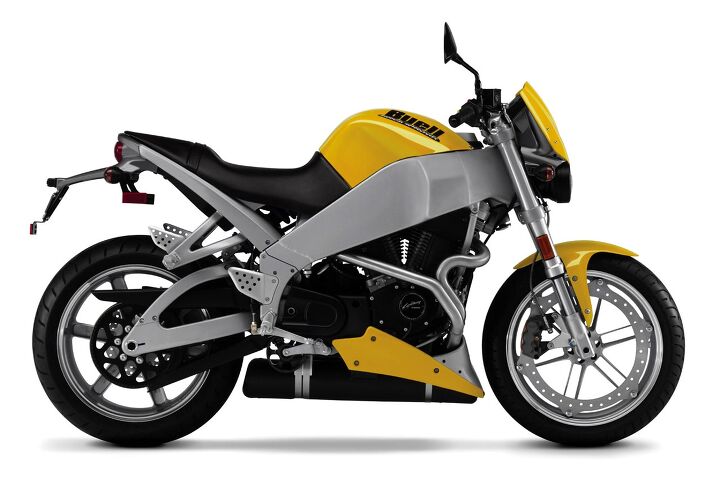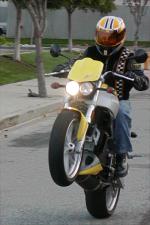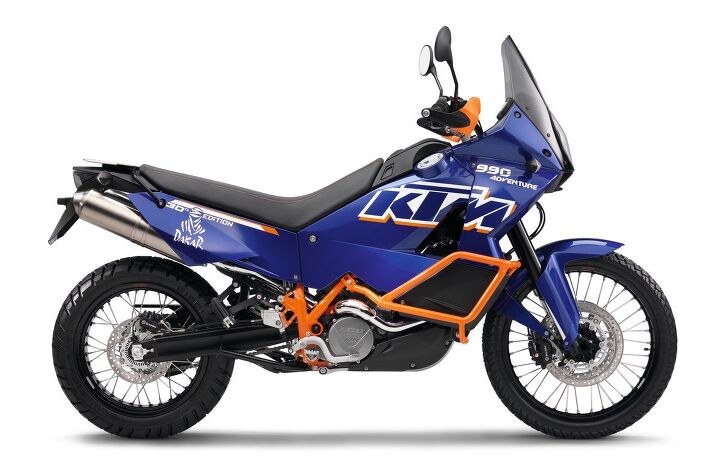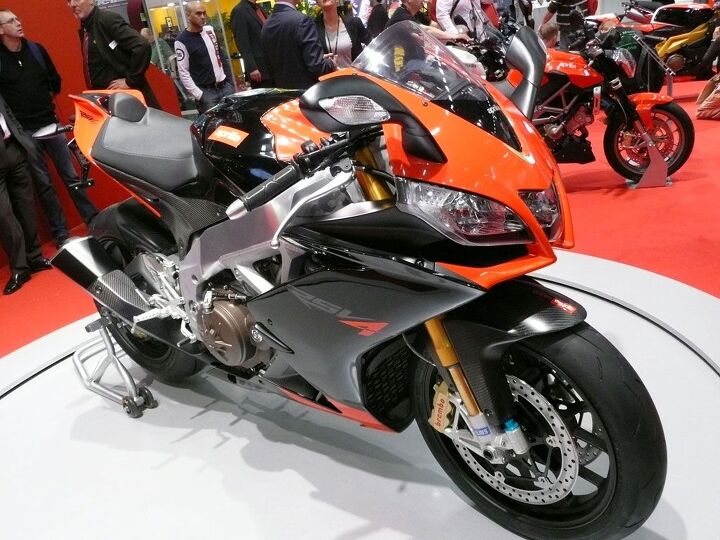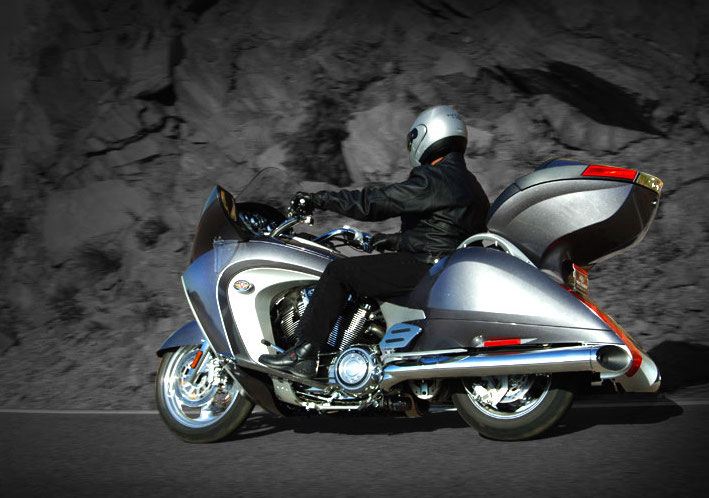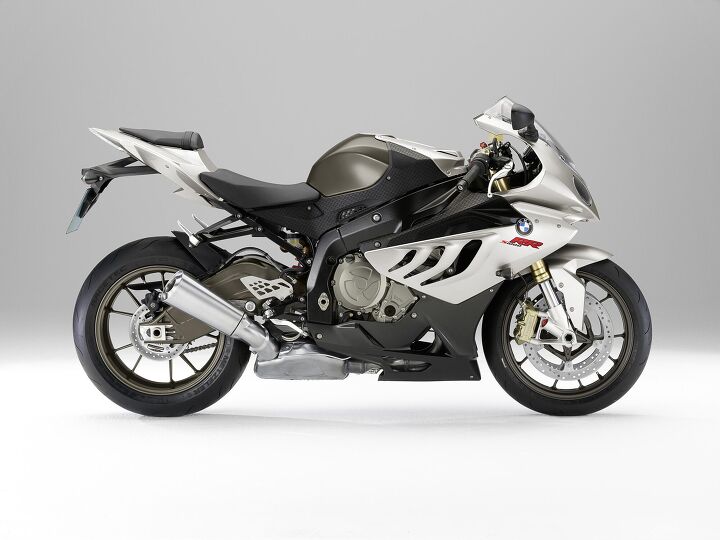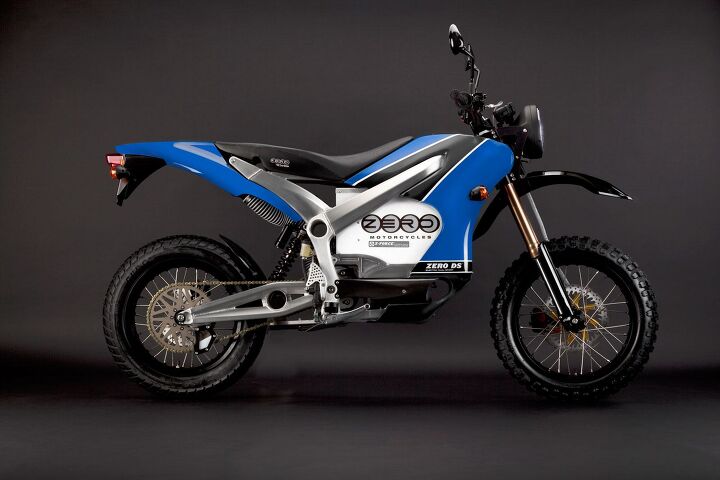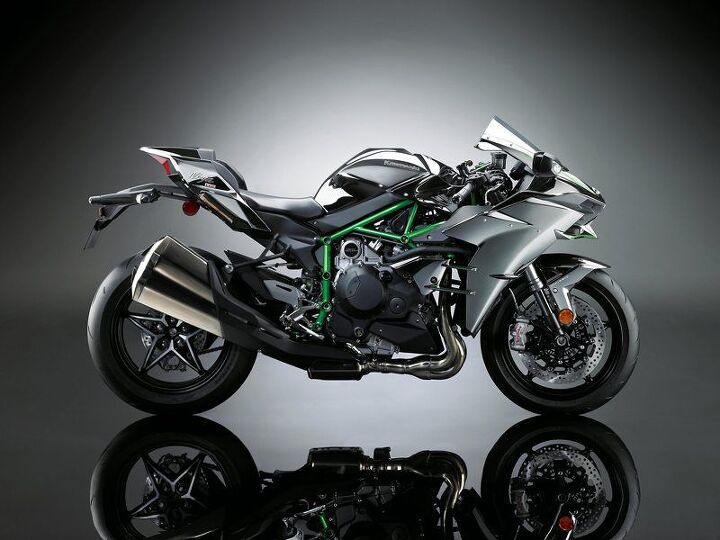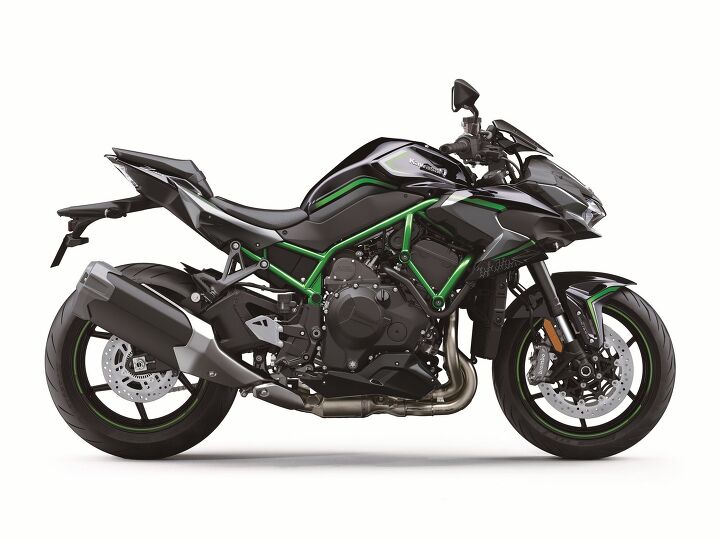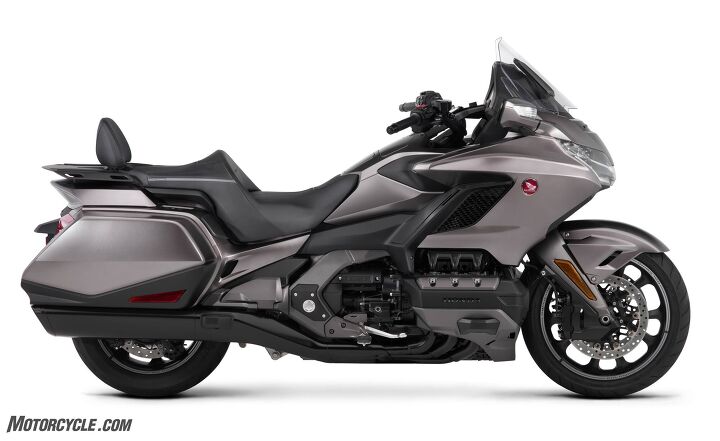Has it really been 20 years since the world didn’t seize up at the stroke of midnight, as we feared it might? Yes. Every time I walk out into the garage, my 2000 R1 sitting dormant on its stand (the last year of the first-gen R1) reminds me of what a long time ago that was. Next to all the new bikes it sees come and go, the old girl is positively archaic. In a good, Ann-Margret way, but still. While we’re still quarantining seems like a good time to look back upon what bikes have moved the game forward the most since the millennium.
2001 Triumph Bonneville
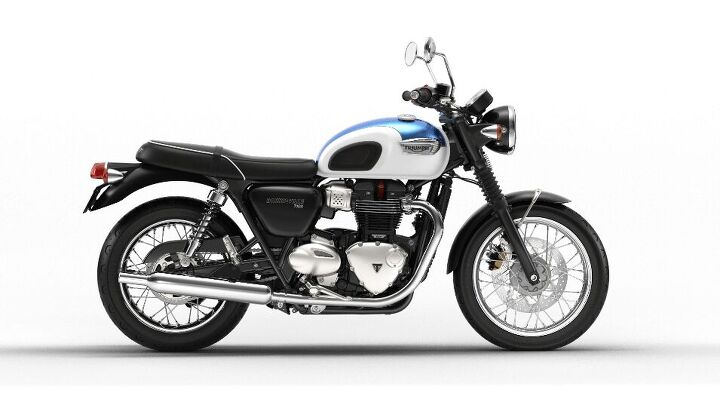
This 2020 T100 Bonneville in Aegean Blue is quite a bit more refined than the ’01, but you get the picture.
Triumph’s first bike back in America in the modern era was the classically styled Thunderbird of 1994, powered by a not-so classical liquid-cooled Triple. Great bike, really, but not what America was looking for apparently. Mixed messages. Back to the drawing board, and seven years later, the Hinckley boys released an all-new Bonneville powered by an air-cooled 8-valve parallel Twin. Ah. Triumph hasn’t looked back since. Though it produces some great sportbikes – including the current Street Triple 765, whose engine powers Moto2, and though upon start-up Triumph really had in mind to compete with the Japanese crotch rockets – it’s the “Classic” Twins that have done all the heavy lifting for the last two decades. The Bonneville begat the excellent new Speed Twin, the also-excellent Street Twins, your Thruxtons, your Scrambler 1200s… It’s worked out well for Triumph so far.
2002 Suzuki V-Strom 1000
Based on the original beak bike and everybody’s favorite current Suzuki. What it might lack in all out top-end power it makes up for with low-rpm lunge as soon as you give it a little gas, and if the V-Strom didn’t used to be the most feature-laden, it was always one of the lightest big adventure bikes, and always the most affordable and easiest to keep.
If you need an example of how racing improves the breed, the V-Strom 1000’s engine would not exist if Superbike rules in the old days hadn’t made 750 fours race against 1000cc twins, resulting in TL1000s “S” and “R” once upon a time. Both of those came and went, long-lost old flames, but the V-Twin, now highly evolved and 1037 cc, cannot be killed.
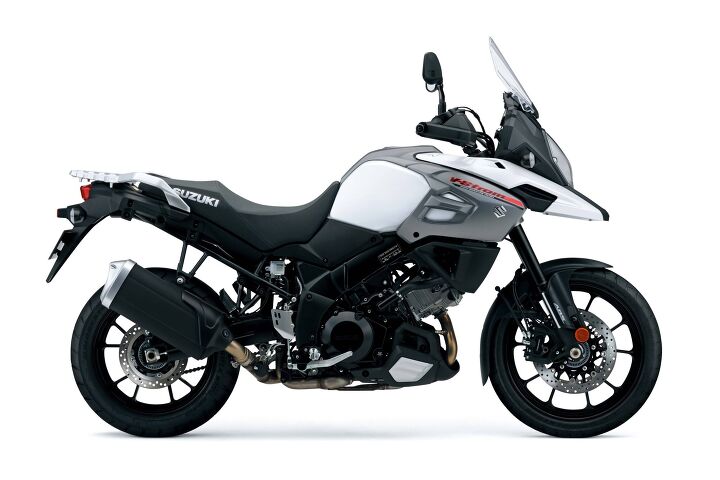
Though many may poo-poo, I didn’t mind the looks of the last generation, like this 2018, even if the 2020 we’re currently testing is svelter and sharper.
Now into its 18th year of production in the form of the heavily revamped 2020 V-Strom 1050, you can have it your way, with all the modern condiments including cruise control and SIRS (Suzuki Intelligent Ride System), to include lean-sensitive combined braking and ride modes controlled by a new six-axis IMU.
Suzuki happily admits its ADV bike leans a bit more toward street use, which suits most of us old sportbike guys fine, though dirt roading is certainly well within its realm. Also commuting to work, bringing home the groceries, going to Montana… meant to be used and abused since 2002.
2003 Buell XB9S
It’s not just because it’s one of my personal favorites of the last 20 years, it’s that this little Buell of mine also represents what might have been, and not just when it comes to motorcycles. The kind of things you think about when you can’t sleep at 3 am, the things you wish you could undo. The first streetable Buell, the RR1000, was a Rube Goldbergian contraption and who is this Erik Buell person? The later steel tube-framed ones of the mid-’90s were a big improvement. But the Verlicchi-framed XBs were a genius exercise in making a silk purse out of what you’ve got, an 883 Sportster engine (punched out to 984), to create a motorcycle that weighed 425 pounds, had dimensions similar to my Yamaha TT-R125L, and was a blast to root up the urban maze feral-hog style. It did only have 80 super-torquey horsepower, but that’s only because the powers that were at Harley-Davidson shitcanned the long-planned turbocharger at the last minute: Anyway, 80 seemed like plenty.
Erik Buell sounds like he might have been a difficult person to get along with in a work environment. So are lots of perfectionists and geniuses. I never rode one, but plenty of people still love their Ulysses XB12s – a radical ADV bike that got here when ADV was just becoming a thing. Let’s hope Harley’s new Pan America will be even better when it arrives. I’m not holding my breath.
2006 KTM 990 Adventure
Before last year, when an American on a Honda did the deed, KTM had won 18 consecutive Paris-Dakar rallies beginning in 2001. Cashing in on that rock-hard legacy, it was the 990 Adventure that first really imprinted Ready to Race on the American motopsyche, at just about the time ADV bikes were beginning to usurp sport ones. If BMW created the category with its GS line, it was KTM that added high-performance to the equation. Its new 999 cc 75-degree fuel-injected V-twin had 105 horses capable of putting out Miss Budweiser levels of roost (surprising when you’re doddling along on an XT350 and get passed by one), from a lightweight (compared to the competition at least) package with over 8 inches of heavy-duty suspension travel. We’re no longer taking the long way round, we’re going over the top and straight through the middle.
For KTM, it’s been nothing but bigger and better Adventures ever since – though the 1090 of 2017 was a step toward right-sizing, and this year’s 790 Adventure an even better one – along with a spate of Dukes and Super Dukes you may have been unable to ignore in the pages of MO. Sportbikes Schmortbikes: The Austrians dropped their excellent RC8 after the 2015 model year, and haven’t looked back yet.
2008 Aprilia RSV4
What the? The bike we begged Honda for forever was finally produced by a small manufacturer in Italy, and a full decade before that other more famous Italian manufacturer got around to bestowing upon us its V-Four. Our man Yossef Schvetz reported from Intermot 2008:
This wasn’t supposed to happen. Since Milan’s EICMA show was turned into a yearly event, the Big Four usually choose either the Intermot or the Paris show to introduce their new wares. Who wants to be overshadowed by those flashy Italians? And yet, the star of the German Intermot show was an Italian bombshell.
Next to the cyclic revamps to the Japanese 1000cc superbikes (It’s Yamaha and Suzuki’s turn this year), Aprilia’s leap into the void with it’s brand new V4 “Race Machine” looks like a real revolution. The bike was unveiled right after the last WSBK round in Rome, Italy, but this was the first chance to see it from up close. And, it’s the bollocks, as true Brits would say.
The latest 2020 65-degree V-four iteration claims 217 horsepower and 90 foot-pounds of torque, advanced electronics that make it nearly impossible to crash (sarcasm), and wings (not Honda ones).
The Tuono V4 naked version is the preferable streetbike, but the no-holds-barred RSV4 was laying down rubber on the track four years before it appeared, in 2012. Though it’s long in the tooth now, like our boy Troy said at the end of last year’s RSV4 Factory first ride, age ain’t nothing but a number.
2008 Victory Vision
Bear with me. This was a highly advanced big American-built V-Twin touring bike with superior comfort and performance, outstanding fit and finish and slightly revolutionary styling – all good right up until that last part. When people didn’t see its Vision, Victory tried to dumb things down in the form of the Cross Country and Cross Roads, and when that didn’t work they said f#@k it and bought Indian. In fairness, the Great Recession didn’t help the Vision at all.

Let me know if you come across a clean Vision 8-Ball, slammed and stiffer of suspension for better handling. Wait, they’re still above $8k ten years later…
Reportedly, the Vision was Polaris’ biggest investment to date in a single product. Without the failure of the Vision, followed by the eventual folding up of Victory, would we have ever gotten to Indian, and would that have been a good or bad thing? Maybe we’d have gotten to some more original American motorcycles, like the FTR1200 and Challenger, that much sooner. Either way, the Vision was a great failure that led to the still mostly conservative current state of American motorcycles.
2009 BMW S1000RR
Nobody told BMW sportbikes were passé when they launched this missile, signalling they were now ready to go head-to-head with the GSX-Rs and YZFs of the world instead of being content to putter around on sportbikes powered by Boxer twins. Then again, they’re not stupid over there in Bavaria:
“The very fascination of this motorcycle with its racing DNA expands and upgrades the brand image of BMW Motorrad by offering an additional sporting and emotional element winning over new customers for the brand,” said Hendrik von Kuenheim, General Director of BMW’s motorcycle division, noting that the class accounts for more than 100,000 units worldwide. “We are actively looking for new options, for profitable growth and for the planned increase in volume. Precisely that is why we have decided, among other things, to take on the competition in the Supersports segment on both the road and the race track.
“As part of the strategic reorientation of the BMW Group, we have announced that customer deliveries by BMW Motorrad are to increase by approximately 50% by the year 2012 to 150,000 units. To meet this objective, we are making BMW Motorrad even more sporting and dynamic. This means that we are specifically entering market segments where BMW Motorrad was not represented so far.”
Not only did the new RR enter the segment, it redefined it. Though Aprilia already had traction control on its 2008 RSV4 and so did Ducati on the 2009 1098, BMW moved the ball forward on the S1000RR with Dynamic TC, Race ABS, quickshifter – all of it aided and abetted by “a gyro under the seat” which we now refer to as the IMU, without which any current sportbike dare not enter the arena. With this 193-hp bike, we truly entered the age of electronic rider aids, and all of us are more physically intact for it.
2010 Zero S and DS
The electric motorcycle, everybody keeps telling us, is the future. If that’s the case, Zero got there before everybody else, in a legitimate way, ten years ago with its S (Supermoto) and DS (Dual Sport) models, featuring a proprietary lithium-ion manganese (Li-On) battery designed and assembled at the company’s Scotts Valley, California, facility. Ten years later, the big battery breakthrough (BBB) remains elusive, but Zero’s gotten a lot closer to the grail with last year’s really impressive, third-generation Zero SR/F.
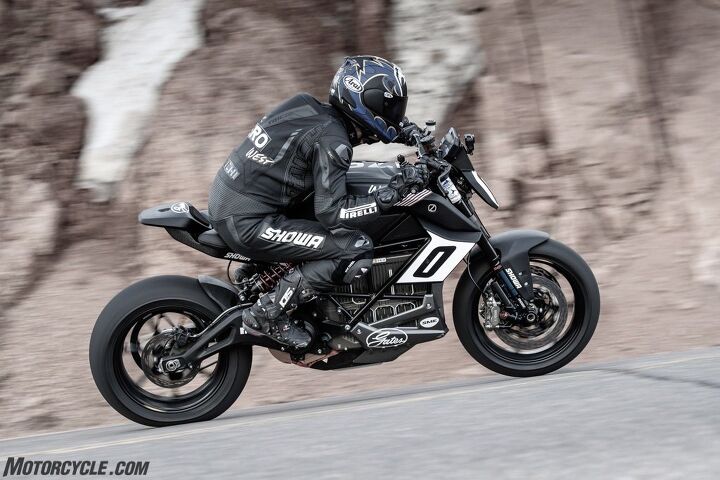
Cory West rode this modified SR/F to the summit of Pikes Peak in 10:46.233 last year, making it the ninth-fastest motorcycle in the race, and second electric behind a dedicated racer built by the University of Nottingham (10:19.040).
Production standards are greatly improved on the new bike, and the standard SR/F’s ZF75-10 motor puts out 140 lb-ft of torque, 110 hp and is good for 124 mph. Now with integrated Level 2 charging on the base model, full-charge time is down from 9 to 4.5 hours – with an available Charge Tank option that allows a 95% electron fill-up in about an hour. The SR/F’s claimed range of 161 miles in the city (adding a Power Tank bumps it to over 200 miles), 82 miles highway, and 109 miles combined, remains every electric bike’s weak spot. But for thousands of people who commute 20 or 30 miles a day and will never stop for gas again, it’s also completely beside the point.
Zero’s watched other electric bike companies come and go, it’s listened to lots of big claims from would-be competitors. Meanwhile, It just quietly goes about the business of inventing the future.
2015 Kawasaki H2R/ H2
When the experts told Kawasaki they couldn’t put a supercharger on a motorcycle without a bulky intercooler, its engineers said “hold our sake,” and the outrageous 300-horsepower H2R hyperbike was the result, followed right up by the street-legal H2 rated at only 197 hp (a lie). It helps to have an in-house aerospace division when you need to cut an aluminum impeller to spin at 130,000 rpm and compress incoming air 2.4 times over atmospheric pressure.
Kawasaki didn’t need to do it, but they did it anyway. And the rest of the probably most advanced motorcycle the world has ever seen served also as a reminder of Kawasaki’s engineering prowess, lest anyone had forgotten since the original, more crude H2 of 1972.
This was Kawi’s first trellis frame (a pretty green one that’s trickled right down to the $8,999 Z900). It let the engineers put strength exactly where they wanted it, while allowing plenty of cooling airflow. Some of the perfect welds are by Kawasaki robots, others are welded by expert Kawasaki craftsmen.
More than any Kawasaki motorcycle to date, said Kawasaki at the time, the Ninja H2 is a showcase of craftsmanship, build quality and superb fit and finish – right down to the specially developed high-tech mirror-like paint. In the shade, the paint appears black, but in sunlight its highly reflective silver-layered surface takes on the appearance of the surrounding scenery. That interplay of light and shade emphasizes the curvature of the bike’s bodywork – into which the aerodynamics people also invested many man hours.
Unlike a typical nose-down sportbike, the H2 stance is very neutral, almost flat like a Formula 1 car – to make the body as aerodynamically sleek as possible. Quick turn-in is less important than reduced drag and top speed. Wings and mirror mounts were carefully crafted to aid the mission. Also unlike a ZX-10R, “the impression from the rider’s perspective is not one of austerity, but is more about quality, high-tech control and the impeccable fit and finish.“
Funny, that’s just what we thought when we got to ride the 2018 H2 SX SE sport-tourer, which gets you a comfortable cockpit, Swedish-feeling suspension, cruise control, saddlebags and a quickshifter along with your 171 horses at the contact patch (at only 10,300 rpm). Now there’s a brand-new 2020 Z H2 naked version, too. Doing more with less (the SX SE averaged around 40 mpg) for a reasonable price, is what it’s all about.
2018 Honda Gold Wing
For 40-some years the Gold Wing got bigger and fatter and older. That all came to an ABS-rapid halt when Honda decided the time was ripe to go for a younger, sportier audience. Honda says the new Gold Wing Tour (the one with the top box) weighs 90 pounds less than its predecessor. On the road, the bagger version almost feels like it lost even more. That’s down to a new double-wishbone front suspension doing away with those archaic old forks, which allowed shoving the ethereal boxer-Six engine closer to the front contact patch, resulting in the kind of glued-to-the-road handling you only find in bikes with big crankshafts running longitudinally within the frame spars.
The 1833 cc Six was also completely reworked, and while its 100-horsepower top end doesn’t seem so impressive, it’s the 100 pound-feet of torque just barely off idle that makes the Gold Wing so much of a hoot to ride, especially the Dual Clutch Transmission version that lets you pin the throttle in Sport mode and watch the tach needle bounce off the redline seven times. (Well, almost: Our ’18 model had a 110-mph governor.) All that and 41 mpg for our test unit, how I miss it…
It’s enough to make you almost forget this is still a luxury touring motorcycle with a big TFT display, elaborate nav and sound systems, an electric windscreen, central locking bags and blissful seating for two lower than 30 inches.
Missed it by that much:
1999 Suzuki SV650
What can we say? It missed the year-2000 cut-off date. No other bike was so bandied about for this list, though. Suzuki’s affordable answer to the Ducati Monster soldiers on.
1998 Yamaha YZ400F
Bringer of the four-stroke revolution to off-road riding.
The post Top 10 Groundbreaking Motorcycles of the 21st Century (So Far) appeared first on Motorcycle.com.
【Top 10 Malaysia & Singapore Most Beautiful Girls】Have you follow?
